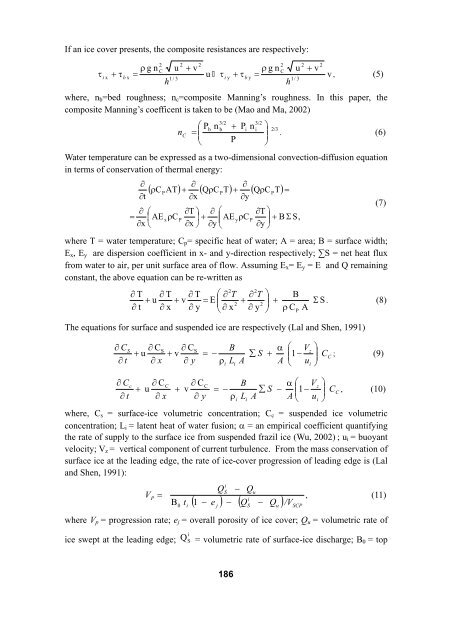Create successful ePaper yourself
Turn your PDF publications into a flip-book with our unique Google optimized e-Paper software.
If an ice cover presents, the composite resistances are respectively:<br />
2 2 2<br />
2 2 2<br />
ρ g n<br />
C<br />
u + v<br />
ρ g n<br />
C<br />
u + v<br />
τ<br />
i x<br />
+ τb<br />
x<br />
=<br />
u τ v<br />
1/ 3<br />
i y<br />
+ τb<br />
y<br />
=<br />
, (5)<br />
1/ 3<br />
h<br />
h<br />
where, n b =bed roughness; n c =composite Manning’s roughness. In this paper, the<br />
composite Manning’s coefficent is taken to be (Mao and Ma, 2002)<br />
⎛ P n +<br />
⎜<br />
⎝ P<br />
P<br />
n<br />
⎞<br />
⎟<br />
⎠<br />
3/2<br />
3/2<br />
b b i i 2/3<br />
n = ⎜<br />
⎟<br />
C<br />
. (6)<br />
Water temperature can be expressed as a two-dimensional convection-diffusion equation<br />
in terms of conservation of thermal energy:<br />
∂<br />
∂t<br />
( ρC<br />
AT) + ( QρC<br />
T) + ( QρC<br />
T)<br />
P<br />
∂ ⎛<br />
= ⎜AE<br />
xρC<br />
∂x<br />
⎝<br />
P<br />
∂<br />
∂x<br />
∂T<br />
⎞<br />
∂x<br />
⎟ +<br />
⎠<br />
P<br />
∂<br />
∂y<br />
∂ ⎛<br />
⎜AE<br />
yρC<br />
∂y<br />
⎝<br />
P<br />
P<br />
=<br />
∂T<br />
⎞<br />
⎟ + B Σ S,<br />
∂y<br />
⎠<br />
where T = water temperature; C p = specific heat of water; A = area; B = surface width;<br />
E x , E y are dispersion coefficient in x- and y-direction respectively; ∑S = net heat flux<br />
from water to air, per unit surface area of flow. Assuming E x = E y = E and Q remaining<br />
constant, the above equation can be re-written as<br />
2<br />
∂ T ∂ T ∂ T ⎛ ∂ T<br />
+ u + v = E<br />
2<br />
t x y<br />
⎜<br />
∂ ∂ ∂ ⎝ ∂ x<br />
2<br />
∂ T ⎞<br />
+ +<br />
2<br />
y<br />
⎟<br />
∂ ⎠<br />
ρ<br />
(7)<br />
B<br />
Σ S . (8)<br />
C A<br />
The equations for surface and suspended ice are respectively (Lal and Shen, 1991)<br />
P<br />
∂ C<br />
∂ t<br />
S<br />
∂ C<br />
+ u<br />
∂ x<br />
S<br />
∂ C<br />
+ v<br />
∂ y<br />
S<br />
=<br />
−<br />
ρ<br />
i<br />
B<br />
L<br />
i<br />
A<br />
∑ S<br />
+<br />
α<br />
A<br />
⎛ V<br />
⎜ −<br />
⎝<br />
⎞<br />
⎟<br />
⎠<br />
C<br />
z<br />
1<br />
C<br />
u ⎟ ; (9)<br />
i<br />
∂ C<br />
∂ t<br />
c<br />
∂ CC<br />
+ u<br />
∂ x<br />
∂ CC<br />
+ v<br />
∂ y<br />
= −<br />
ρ<br />
i<br />
B<br />
L<br />
i<br />
∑ S<br />
A<br />
V<br />
−<br />
α A<br />
⎜<br />
⎛ −<br />
⎝<br />
⎞<br />
⎟<br />
⎠<br />
z<br />
1 CC<br />
u ⎟ , (10)<br />
i<br />
where, C s = surface-ice volumetric concentration; C c = suspended ice volumetric<br />
concentration; L i = latent heat of water fusion; α = an empirical coefficient quantifying<br />
the rate of supply to the surface ice from suspended frazil ice (Wu, 2002) ; u i = buoyant<br />
velocity; V z = vertical component of current turbulence. From the mass conservation of<br />
surface ice at the leading edge, the rate of ice-cover progression of leading edge is (Lal<br />
and Shen, 1991):<br />
V<br />
P<br />
=<br />
B 0<br />
t<br />
i<br />
Q<br />
i<br />
S<br />
−<br />
Q<br />
i<br />
( 1 − e<br />
j<br />
) − ( QS<br />
− Qu<br />
)/VSCP<br />
u<br />
, (11)<br />
where V p = progression rate; e j = overall porosity of ice cover; Q u = volumetric rate of<br />
ice swept at the leading edge;<br />
i<br />
Q<br />
S = volumetric rate of surface-ice discharge; B 0 = top<br />
186

















